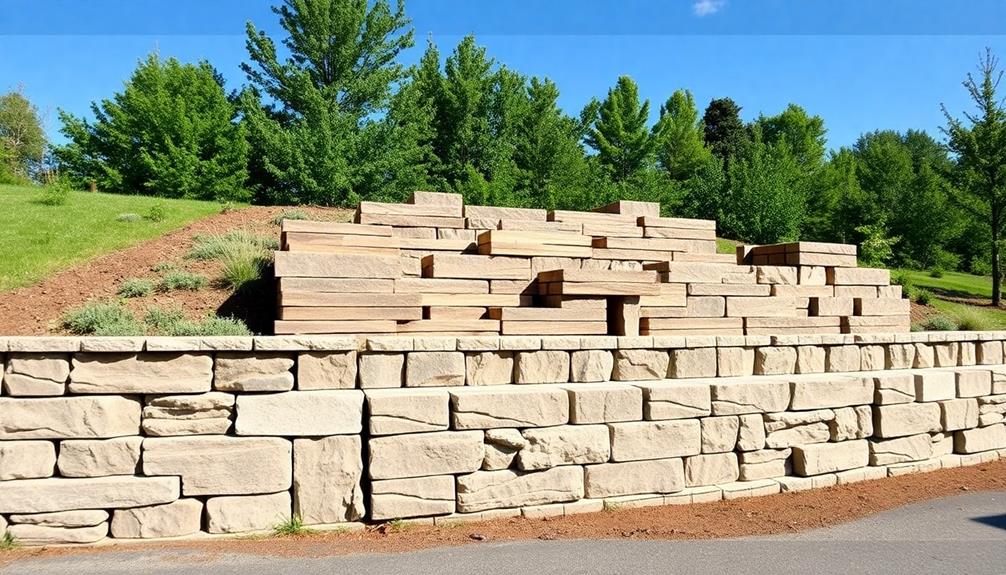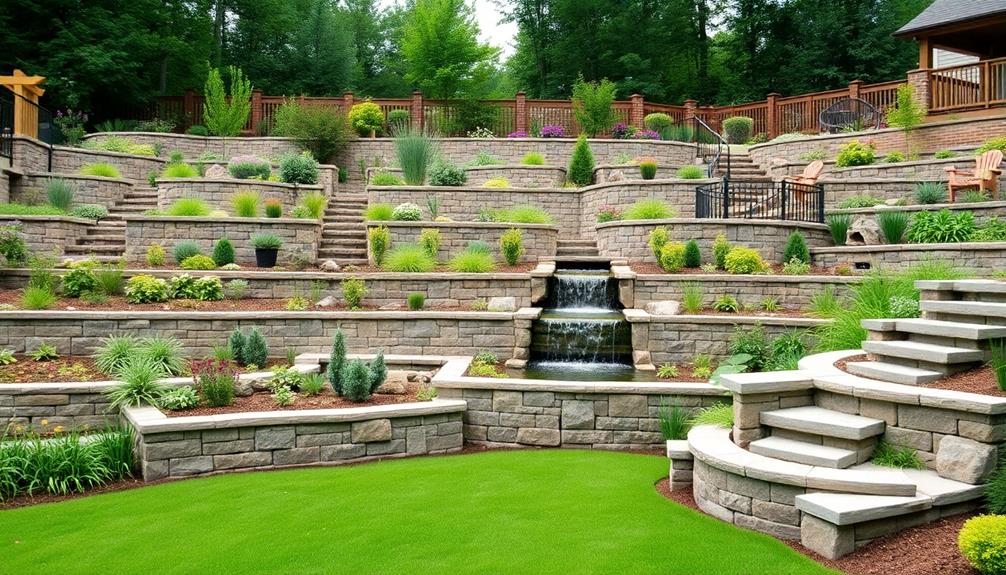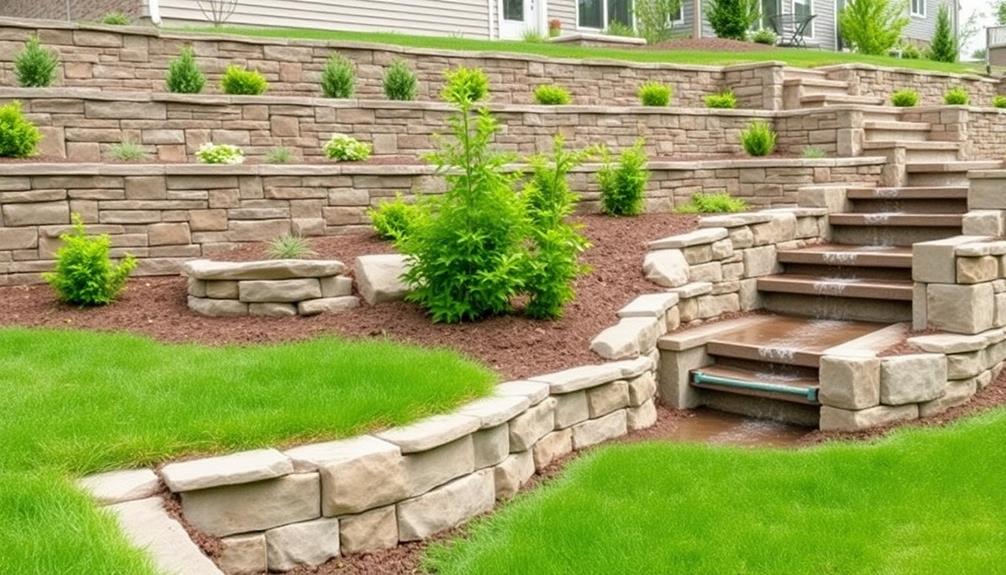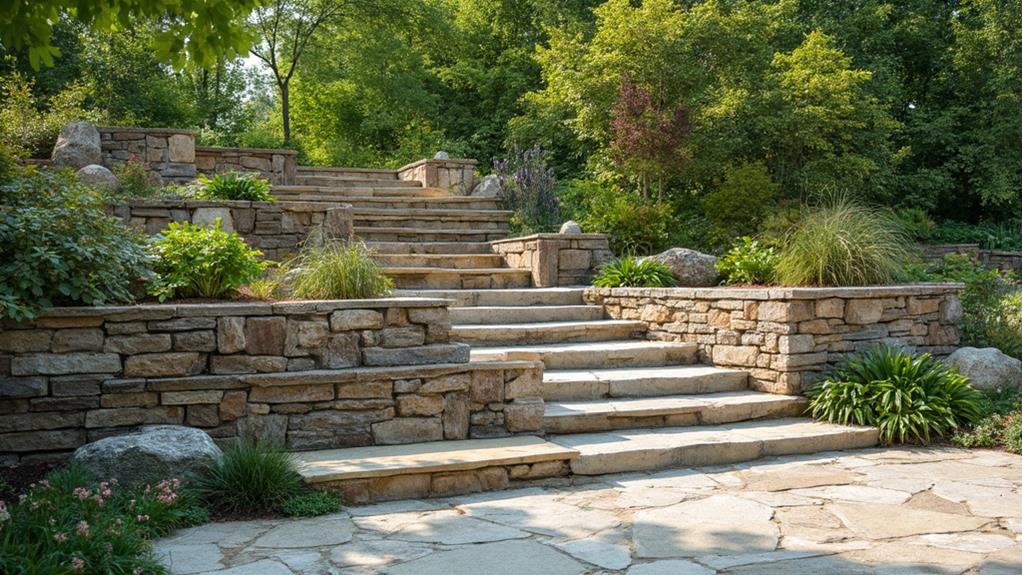Selecting the appropriate materials for retaining walls is crucial for achieving both durability and visual appeal in landscape designs. Concrete blocks offer exceptional structural integrity with low maintenance, while natural stone provides resilience and organic beauty. Treated timber, though slightly less durable, offers flexibility and rustic charm, requiring regular care. Boulders deliver a unique aesthetic and sustainable appeal, demanding minimal upkeep. For robust solutions, reinforced concrete stands out with its unmatched strength and longevity. Additionally, cost-effective alternatives like recycled materials offer economical benefits. Understanding these materials helps in aligning choices with landscape needs and sustainability goals for successful implementations.
Table of Contents
ToggleWalls Contractor Highlights
- Concrete blocks are durable, low-maintenance, and versatile for various landscape aesthetics.
- Natural stone offers timeless beauty and resilience, integrating seamlessly into natural landscapes.
- Reinforced concrete provides long-term strength, stability, and resistance to weathering.
- Treated timber offers rustic charm but requires regular maintenance to ensure longevity.
- Boulders provide a sustainable, low-maintenance solution with exceptional structural durability.
Defining Retaining Wall Essentials

In order to establish a thorough understanding of retaining wall essentials, it is crucial to first examine their primary purpose and functionality, which involve providing necessary support for soil lateral pressure while enhancing landscape aesthetics. These structures prevent erosion on properties and create usable areas for gardening, patios, and parking, further augmenting their value.
Additionally, the interplay between design and engineering cannot be overstated, as these components not only contribute to the structural integrity of the wall but also allow for innovative and site-specific solutions. Finally, considering the lifespan and durability of various materials guarantees that the wall remains effective and visually appealing over time, ultimately influencing maintenance needs and cost-effectiveness for long-term projects.
Purpose and Functionality
Serving as both a structural necessity and an aesthetic enhancement, retaining walls are indispensable in managing earth and water on various landscapes. These structures are meticulously engineered to prevent soil erosion, stabilizing slopes and gradients which otherwise succumb to the relentless forces of nature. By performing these pivotal functions, retaining walls confirm the long-term viability and safety of spaces we cherish, transforming undulating terrains into usable foundations that support our vibrant communities' growth.
Moreover, retaining walls fulfill vital hydrological roles by directing surface runoff, thus mitigating the risk of flooding and erosion. This management of water flow helps protect property and landscape investments, preserving their beauty and utility for years to come. Additionally, these walls provide the opportunity to create visually appealing terraced gardens and elevated planting areas, offering functional zones within a coherent landscape design.
In essence, retaining walls do not simply serve practical purposes; they embody the harmony between human innovation and environmental stewardship. When constructed with precision and care, these structures contribute to the collective sense of belonging we seek from the places we inhabit, imbuing them with an enhanced function and form that resonate with our community values.
Design and Engineering
Effective design and engineering are the cornerstones of a reliable retaining wall, blending structural integrity with aesthetic considerations. When contemplating such structures, it is essential to anchor technical precision to foundational concepts, ensuring that both form and function harmoniously coexist.
At the heart of this endeavor is the need to address challenging site gradients, variations in soil composition, and water drainage issues, each requiring bespoke engineering solutions tailored to unique environmental contexts.
A critical aspect involves meticulous planning, where detailed surveys and soil analyses inform the design process, guiding the selection of appropriate materials and techniques. This phase guarantees the retaining wall's ability to withstand the lateral earth pressure exerted by retained soils.
Key design principles, such as gravity, cantilever, and anchored designs, offer diverse solutions to achieve stability and durability, depending on wall height and land use.
Equally significant is the integration of visually appealing elements, which add value and cohesion to the surrounding landscape. Employing materials like stone, concrete, or brick, professionals balance engineering precision with design finesse, creating walls that both perform their intended function and enhance the property's overall aesthetic. Such attention to design and engineering fosters trust among homeowners and professionals alike.
Lifespan and Durability
A retaining wall's lifespan and durability are fundamental attributes that determine its long-term effectiveness and reliability. When crafted from robust materials, a retaining wall not only stands the test of time but also guarantees safety and structural integrity, fostering a sense of belonging in its environment. Different materials offer varied lifespans and durability levels, and understanding these is key to selecting the right option for your project.
Concrete: Known for its strength and resistance, reinforced concrete walls can last over 50 years if correctly maintained. Their durability against weather fluctuations and erosion makes them a popular choice for those seeking stability and longevity.
Natural Stone: With its timeless appeal, natural stone is inherently sturdy, often enduring for decades. However, its durability is contingent on proper installation and drainage solutions, which prevent water accumulation and potential damage.
Timber: While aesthetically pleasing, timber walls generally have a shorter lifespan, approximately 20 years, due to susceptibility to rot and pests. Treatments and protective coatings can extend their longevity, but regular maintenance is imperative.
Benefits

Understanding the advantages of various retaining wall materials is essential in selecting the right option for any project. For example, boulder walls provide a unique, natural aesthetic while offering exceptional structural durability and low maintenance needs.
These materials not only provide durability and longevity, ensuring the structure withstands the test of time, but they also offer cost-effectiveness, blending value with aesthetic appeal tailored to diverse landscape designs. Additionally, the choice of materials encompasses environmental impact considerations, allowing for sustainable practices that align with modern ecological standards.
Durability and Longevity
Durability and longevity are critical factors when selecting retaining wall materials, ensuring long-term performance and minimal maintenance. A well-selected retaining wall material stands the test of time, reflecting a commitment to quality and endurance.
Different materials offer varying degrees of strength and resilience, with some better suited to withstand environmental challenges like erosion and weathering. This selection is pivotal for the structural integrity and aesthetic permanence of landscaping designs, reinforcing a connection with the environment that fosters a sense of belonging.
- Concrete Blocks: Known for their exceptional durability, concrete blocks resist the pressures of both time and nature's elements. Their robust composition provides enduring support, maintaining stability for decades with minimal upkeep.
- Natural Stone: This classic choice offers both beauty and resilience, seamlessly integrating into natural landscapes. Natural stone's inherent durability is complemented by its ability to adapt to various climates, ensuring a long-lasting and visually appealing solution.
- Treated Timber: While slightly less durable, treated timber offers a rustic charm and durability when properly maintained with preservatives. It provides both flexibility in design and an organic appeal, anchoring outdoor spaces with warmth and woody character.
Cost-Effectiveness and Value
Selecting the right materials for a retaining wall extends beyond durability to encompass cost-effectiveness and overall value. When considering such an investment, it is crucial to assess material costs against the longevity and maintenance savings they provide over time. Concrete blocks, while initially more expensive than alternatives like timber, present significant long-term savings with minimal upkeep and a robust lifespan.
Additionally, while stone walls may require a substantial upfront investment, their resilience against environmental factors guarantees fewer repairs, enhancing overall value and reducing future expenditures.
Materials like recycled or composite options present an economical yet effective solution while contributing to sustainability. These materials often offer competitive longevity and cost savings without compromising strength.
In addition, modular and pre-cast concrete blocks offer a fusion of affordability and convenience, reducing both installation time and labor costs.
Evaluating the cost-effectiveness and value of retaining wall materials also implicates considering the project's scale, as bulk purchasing for larger endeavors might present opportunities for discounts, further optimizing budgets. Consequently, the choice of materials should align with the community's financial objectives, ensuring that they contribute not only to property safety and function but also to economic responsibility and shared prosperity.
Aesthetic Appeal Options
While cost-effectiveness and value are key considerations, the aesthetic appeal of retaining wall materials holds equal significance in enhancing landscapes and elevating property value. Choosing the right material can transform an ordinary garden or yard into an inviting and cohesive outdoor living space that resonates with personal taste and community identity. The choice of aesthetic options not only reflects the homeowner's style but also contributes to an environment where neighbors feel connected.
Consider the benefits of integrating aesthetic options into retaining wall materials, as illustrated by the following features:
- Varied Textures and Colors: Retaining wall materials offer an array of finishes and shades to complement any architectural style or landscape design, from natural stone for a rustic charm to sleek concrete for a contemporary look.
- Customizable Designs: Modular blocks or decorative stones allow for personalized layouts, offering the flexibility to incorporate curves, terraces, and unique patterns that harmonize with the surroundings.
- Compatibility with Vegetation: Many retaining wall materials facilitate planting, which can enhance aesthetic appeal with greenery, turning the wall into a living structure that melds functionality with organic beauty.
Environmental Impact Considerations
When evaluating retaining wall materials, it is crucial to weigh their environmental impact, as sustainable choices can enormously benefit both the ecosystem and the property. Selecting materials that are eco-friendly not only contributes to the preservation of natural resources but also enhances the appeal and long-term functionality of outdoor spaces.
One essential aspect is the utilization of locally sourced materials, which can profoundly reduce carbon footprints associated with transportation. This choice fosters a sense of community, as it supports local economies and reduces environmental degradation.
Furthermore, opting for permeable materials allows rainwater to percolate through the structure, supporting groundwater replenishment and minimizing erosion. This hydrological harmony enriches the surrounding green spaces while maintaining the integrity of the retaining wall itself. Additionally, recycling existing materials, such as repurposing old bricks or concrete, aligns with sustainable practices, minimizing waste and energy consumption in production.
Natural materials, like timber from responsibly managed forests or stone, resonate with those who prefer a natural aesthetic that seamlessly integrates with the landscape. These materials, when selected carefully, can provide long-term durability while being kind to the environment, offering a holistic approach to landscaping that promotes ecological stability and community pride.
Drainage Considerations

Effective drainage considerations are paramount in the design of retaining walls, as they guarantee proper water management, which is vital for maintaining structural integrity and longevity. The selection of permeable materials is critical to facilitate water passage, reducing hydrostatic pressure and preventing soil erosion, thereby safeguarding the surrounding landscape from destabilization. The table below outlines key factors and their impact on drainage performance and overall wall stability:
| Factor | Impact on Drainage | Influence on Wall Stability |
|---|---|---|
| Water Management | Direct flow of water | Minimizes pressure |
| Permeable Materials | Allows seepage | Reduces erosion risk |
| Soil Erosion Prevention | Stabilizes soil | Maintains wall structure |
| Hydrostatic Pressure | Mitigates build-up | Ensures structural soundness |
| Landscape Protection | Protects surrounding areas | Enhances longevity |
Proper Water Management
A pivotal aspect of building and maintaining retaining walls is guaranteeing proper water management through effective drainage considerations. Without adequate drainage, structural stability and functionality might be compromised. Water exerting pressure behind the wall can lead to erosion and even wall collapse. As a result, meticulous attention to drainage systems is paramount in retaining wall design and execution.
The success of such systems can be attributed to three critical components that must be considered:
- Backfill Material Selection: Utilizing gravel or crushed stone for backfill materials guarantees that moisture is not trapped behind the wall. These permeable substances promote efficient water flow and prevent hydrostatic pressure build-up.
- Drainage Pipe Installation: Positioning perforated pipes at the base of the wall is essential for guiding water away. This installation aids in channeling excess moisture out from behind the structure, thereby mitigating potential damage.
- Weep Hole Integration: Strategically placed weep holes allow water to escape through the wall. These holes, placed periodically along the wall length, serve as an effective means to alleviate water pressure and prevent buildup.
Implementing these strategies fortifies the resilience of retaining walls, fostering a secure and lasting structure.
Permeable Material Options
In constructing robust retaining walls, selecting suitable permeable materials is fundamental to effective drainage. These materials guarantee that water does not accumulate behind the wall, which could jeopardize its structural integrity over time. Porous options such as crushed stone or gravel are often utilized, as their loose composition facilitates water movement while maintaining essential support.
Additionally, materials like geotextiles and drainage mats—engineered to promote water flow—can serve as crucial underlays or overlays, enhancing the drainage capability of the entire structure.
Permeable concrete blocks are another innovative solution, merging the structural benefits of concrete with the drainage efficiency of permeable matter. They allow water passage while preventing soil particles from obstructing drainage pathways. Such blocks are becoming increasingly popular in modern landscape architecture, reflecting a harmonious balance between aesthetics and function.
The use of these permeable materials fosters a sense of trust and confidence in the structural stability of retaining walls among property developers and homeowners alike. They provide both a solution and peace of mind, guaranteeing that your retaining wall stands robust against potential hydrostatic pressure. Choosing the right porous materials aligns with a community that values durability and innovation in landscape construction.
Preventing Soil Erosion
Soil erosion remains a significant challenge in landscape management, especially in areas prone to heavy rainfall or steep slopes. Retaining walls play an essential role by stabilizing soil and preventing its displacement, but their effectiveness hinges greatly on proper drainage considerations. An effective drainage system behind retaining walls is crucial to prevent hydrostatic pressure build-up, which can lead to wall failure over time.
Incorporate Drainage Pipes: Installing perforated drainage pipes behind a retaining wall allows for the efficient removal of excess water. The pipes should be sloped to guide water away from the structure, reducing pressure on the wall.
Use of Gravel and Filter Fabric: Layering gravel behind the wall with filter fabric helps facilitate water movement while minimizing soil particle clogging. This combination aids in maintaining a free-draining environment necessary for structural integrity.
Design Considerations for Weep Holes: Integrate strategically placed weep holes into the wall design, which serve as an outlet for trapped water, mitigating the risk of erosion under the wall base.
Well-executed drainage planning not only guarantees the durability of retaining walls but also promotes a sense of community responsibility by contributing to landscape stability and sustainability.
Walls Contractor FAQ
What Are the Most Eco-Friendly Retaining Wall Materials to Consider?
In selecting eco-friendly retaining wall materials, consider options like recycled concrete, sustainably-sourced timber, or gabion walls filled with locally-sourced stones. These choices not only preserve environmental integrity but also foster community by supporting local resources and sustainable practices.
Are There Any Budget-Friendly Options for Retaining Wall Materials?
Yes, budget-conscious options like concrete blocks and timber are available for retaining wall construction. These materials balance affordability with durability, making them suitable for communal projects that seek both economic efficiency and lasting quality for inclusive spaces.
How Do I Determine the Right Height for My Retaining Wall?
Determining the appropriate height for a retaining wall involves evaluating soil type, drainage requirements, and slope stability. Consulting with a structural engineer or landscape expert fosters community confidence and guarantees compliance with safety regulations, harmonizing functional design with shared standards.
Can I Mix Different Materials to Create a Unique Retaining Wall Design?
Mixing different materials in a retaining wall design can create visually striking and innovative structures. However, it is crucial to examine each material's compatibility, structural integrity, and adherence to local building codes to guarantee success and safety.
What Are the Most Durable Materials for High Traffic Areas?
The most durable materials for retaining walls in high-traffic areas include concrete blocks, natural stone, and reinforced masonry. These options are cherished for their strength, longevity, and ability to withstand heavy use, offering peace of mind and community cohesion.







